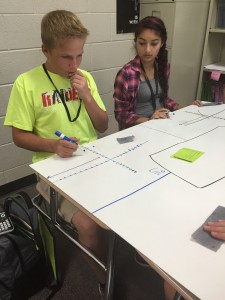3 Simple Suggestions: Growing as a Team–without derailing it!

“Without continual growth and progress, such words as improvement, achievement, and success have no meaning.” – Benjamin Franklin
Growing isn’t easy. Thus, the phrase “growing pains.” Yet, we work in a field that is a highly interpersonal, social experiment in learning. In fact, teams of teachers are assembled to improve teaching and learning, creating opportunities for students to live their best lives possible. It is noble and important. That being said, teachers certainly don’t walk out of our teacher training programs and into the classroom as the best version of our teacher selves. We have to grow! But, as I mentioned early, growing is painful–especially for groups. There are several reasons why this is the case.
In the last 10 years, the greatest decisions for change were legislated at the state and federal level (No Child Left Behind, Response to Intervention, CCSS, NGSS, C3, PBIS, etc). These sweeping changes cannot be simply adopted overnight. After all, in order for meaningful change to occur, teachers need to understand the desired change, believe it is what is best for students, and then be provided time and training to implement the change. This is no easy feat!
While many districts do their best to provide what is necessary to accomplish those things, what often is not addressed however, is how the stress of change affects a group. Studies show that people will respond to change in different ways. A select few will be “Innovators” or “Early Adopters,” also a small number will be considered “Laggards.” Most likely your personality will determine where you’ll land.
Imagine now, that these people are all in the same room tasked with change. The Late Majority and Laggards are often traditional and skeptical. It takes time to for them to internalize the need for change and make important shifts. That being said, if they adopt them, they will do so judiciously. Innovators and Early Adopters are often frustrated with the apparent “unwillingness” to change on the part of Late Majority and Laggards. This will influence their perceptions towards one another negatively and add to the stress of group change.
Innovators and Early Adopters will most likely be eager to get the ball rolling. After all, why not? However, to the Late Majority or Laggards, Innovators and Early Adopters can appear “rash or daring.” The (often necessary GENTLE) pressure to adopt change can be a great source of anxiety to this group, and can manifest itself in anger towards or negative judgments against their colleagues.
Think about it, you can probably graph the faces of your colleagues on this graph right now! Reflect on how it influences your opinions of one another and how you interact. So, what now? How can your group survive the next change that comes their way (Face it! You’re a teacher–the faster you realize it’s part of the gig, the happier you’ll be!)? A few things:
Acknowledge it! Before the next curriculum review or district initiative, admit that change is hard and have a chat about being sensitive to people on both extremes. After all, we can all understand being frustrated by someone who refuses to budge OR being pushed into something we weren’t comfortable doing, right? This would be a great time for a pep talk, “Our goal is for all of us to understand, be comfortable with and implement this change–not just a few of us. We’re in this together!”
Recognize the feelings behind the behavior. If teachers seem angry or frustrated, there is a reason behind it. Is it because the teacher is not convinced that the change benefits students? Are teachers avoiding work because they hope the pressure to change will just disappear if they ignore it? Are they just overwhelmed by the stress of change? All of these are normal reactions, but certainly need to be addressed for a group to work effectively and move collectively towards the goal.
Provide time and training to reduce group stress. As mentioned before, teachers need to understand and believe the innovation is good for students. I don’t know any teachers who, when convinced that there is a better way to serve students, refuse to do so. To be convinced, teachers will need to see the innovation in practice and data that supports the need for change. Meaningful professional development will clearly outline the innovation, rationale for change, and practical strategies towards change. Also, instructional coaching can play a role in group change. Instructional coaches can partner with teachers, making the innovation feel less intimidating as teachers bring the change into their classrooms. Without time and training, the pressure associated with change can feel like a turning vice for a group.
Change in education is inevitable, and need not break your group. Acknowledging personality differences and group dynamics will help you all to keep your sanity in the pursuit of a better way to serve students. At the end of the year, take some time to acknowledge all you accomplished and, though difficult, discuss how you are all better for it!
For more information and resources for dealing with stress of change on your PLC, see this fabulous Learning Forward newsletter.
